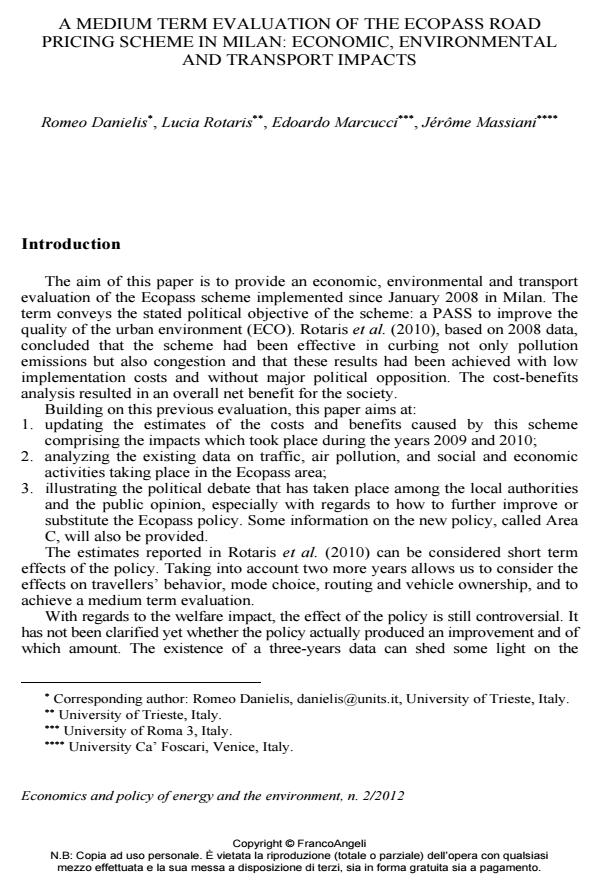A medium term evaluation of the Ecopass road pricing scheme in Milan: economic, environmental and transport impacts
Titolo Rivista ECONOMICS AND POLICY OF ENERGY AND THE ENVIRONMENT
Autori/Curatori Romeo Danielis, Lucia Rotaris, Edoardo Marcucci, Jérome Massiani
Anno di pubblicazione 2012 Fascicolo 2012/2 Lingua Inglese
Numero pagine 35 P. 49-83 Dimensione file 1024 KB
DOI 10.3280/EFE2012-002004
Il DOI è il codice a barre della proprietà intellettuale: per saperne di più
clicca qui
Qui sotto puoi vedere in anteprima la prima pagina di questo articolo.
Se questo articolo ti interessa, lo puoi acquistare (e scaricare in formato pdf) seguendo le facili indicazioni per acquistare il download credit. Acquista Download Credits per scaricare questo Articolo in formato PDF

FrancoAngeli è membro della Publishers International Linking Association, Inc (PILA)associazione indipendente e non profit per facilitare (attraverso i servizi tecnologici implementati da CrossRef.org) l’accesso degli studiosi ai contenuti digitali nelle pubblicazioni professionali e scientifiche
The paper provides an evaluation of the Ecopass road pricing scheme for the years 2008, 2009 and 2010. The term Ecopass conveys the stated political objective of the scheme: a PASS to improve the quality of the urban environment (ECO). The scheme has actually improved the air quality in Milan, although the recommended PM10 threshold is still exceeded for a larger number of days than that recommended by EU directives. This paper estimates the costs and benefits of the scheme three years after its implementation using the same methodology applied in Rotaris et al. (2010) for the year 2008. The results indicate that the benefits still exceed the costs, and by an increasing amount, but at an annual decreasing rate of improvement. The Ecopass scheme has proved beneficial, but it seems to have exhausted its potential: little further gains in air quality could be obtained via a fiscal incentive to improve the abatement technology of the vehicles. The new administration, elected in June 2011, was faced with the task of deciding whether to dismiss, maintain or change the Ecopass scheme. The prevailing idea coming from the Ecopass Commission and from the advocacy groups was to extend both the area of application and the number of classes subject to the charge. In November 2011 the new administration decided to substitute Ecopass with Area C, a policy based on a congestion charge which incorporates some environmental elements.
L’articolo offre una valutazione del modello di road pricing Ecopass per gli anni 2008, 2009 e 2010. Nello stesso termine Ecopass è riassunto l’obiettivo politico dichiarato del modello: un pass per migliorare la qualità dell’ambiente urbano (eco). Il modello ha effettivamente migliorato la qualità dell’aria a Milano, sebbene la soglia di PM10 fissata è stata superata ancora una volta per un numero di giorni più alto di quello fissato dalle direttive UE. Questo articolo stima i costi e i benefici del modello tre anni dopo la sua implementazione usando la stessa metodologia applicata in Rotaris et al. (2010) per l’anno 2008. I risultati indicano che i benefici sono ancora maggiori dei costi e di un valore maggiore, sebbene il tasso annuale di miglioramento sia decrescente. Il modello Ecopass ha migliorato i benefici ma sembra avere esaurito il suo potenziale: ulteriori ridotti miglioramenti nella qualità dell’aria potrebbero essere generati attraverso incentivi fiscali per miglirorare la tecnologia di abbattimento delle emissioni dei veicoli. La nuova amministrazione eletta nel 2011 ha dovuto fronteggiare la decisione di dismettere, mantenere o cambiare il modello Ecopass. L’idea prevalente emersa nella Commissione Ecopass e dai gruppi di sostegno era di estendere sia l’area di applicazione sia il numero di classi soggette alla tariffa. Nel novembre 2011 la nuova Amministrazione ha deciso di sostituire Ecopass con Area C, una politica basata su una congestion charge che incorpora alcuni elementi di tassa ambientale
Keywords:Road pricing, Urban transport, Congestion charge
Jel codes:H23, Q52, R48
- Efficient transport pricing–why, what, and when? Jonas Eliasson, in Communications in Transportation Research 100006/2021 pp.100006
DOI: 10.1016/j.commtr.2021.100006 - Congestion pricing and active transport – evidence from five opportunities for natural experiment. Vicki Brown, Marj Moodie, Rob Carter, in Journal of Transport & Health /2015 pp.568
DOI: 10.1016/j.jth.2015.08.002 - Addressing transportation and environmental externalities with economics: Are policy makers listening? Robin Lindsey, Georgina Santos, in Research in Transportation Economics 100872/2020 pp.100872
DOI: 10.1016/j.retrec.2020.100872 - Is congestion pricing fair? Consumer and citizen perspectives on equity effects Jonas Eliasson, in Transport Policy /2016 pp.1
DOI: 10.1016/j.tranpol.2016.06.009 - Crossing the bridge: The effects of time-varying tolls on curbing congestion Kate Foreman, in Transportation Research Part A: Policy and Practice /2016 pp.76
DOI: 10.1016/j.tra.2016.06.033 - The Gothenburg congestion charges: cost–benefit analysis and distribution effects Jens West, Maria Börjesson, in Transportation /2020 pp.145
DOI: 10.1007/s11116-017-9853-4 - The impact of road pricing on accidents: a note on Milan Marco Percoco, in Letters in Spatial and Resource Sciences /2016 pp.343
DOI: 10.1007/s12076-015-0163-1 - Urban carbon governance and the transition toward low-carbon urbanism: review of a global phenomenon Kevin Lo, in Carbon Management /2014 pp.269
DOI: 10.1080/17583004.2014.981384
Romeo Danielis, Lucia Rotaris, Edoardo Marcucci, Jérome Massiani, A medium term evaluation of the Ecopass road pricing scheme in Milan: economic, environmental and transport impacts in "ECONOMICS AND POLICY OF ENERGY AND THE ENVIRONMENT" 2/2012, pp 49-83, DOI: 10.3280/EFE2012-002004